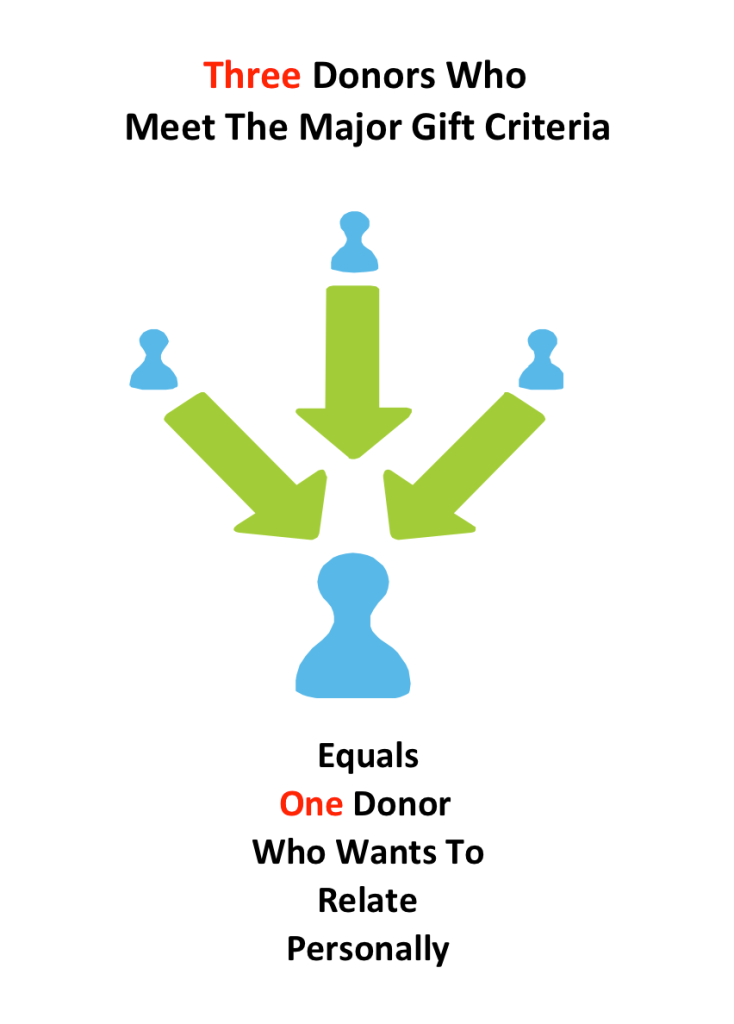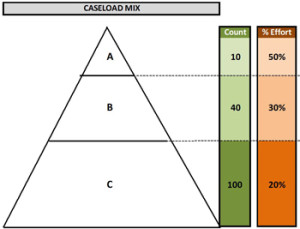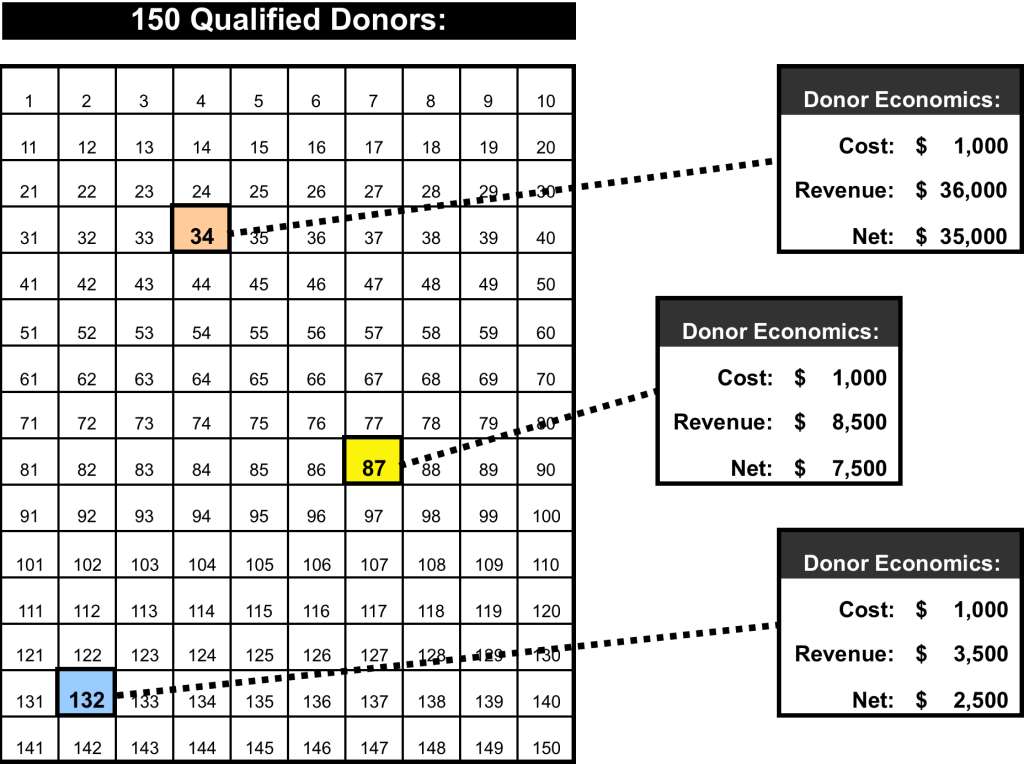We are frequently asked, “Why are you asking me to qualify donors?” There are three reasons:
- Not every donor who meets your major gift criteria actually wants to relate to you.
- You only have so much time.
- You (and your organization) need to be wise stewards of the money that is being invested in you.
Let’s look briefly at each of these.
Most donors do not want to relate personally.
It’s a fact. Just because a donor gave your organization a gift does not mean he wants to relate to you. That may be surprising and disappointing, but it is true. In fact, in our experience is that in the best cases, only one in every three donors who meet your major gift criteria actually wants to connect. Sometimes the ratio is 4:1 or even 5:1.

This reality means that you must uncover a way to find those donors who DO want to relate.
You only have so much time
Look at it this way. A major gift officer should have no more than 150 qualified donors on her caseload. 150 donors. That’s it. You have no other task but to manage those donors. You have 365 days to do that. OK, you have to take weekends and vacation. And there are holidays and business meeting days. So let’s do it this way:
- 365 days in a year
- less 104 weekend days (assuming you will never work a weekend day)
- less 50 days of holidays and organizational business meeting days
- Leaves you 211 days a year or 18 days a month!
18 days a month. That’s all you have.
When you look at it this way, that’s precious little time to do ANYTHING but pay attention to the donors on your caseload. This means:
No prospecting. You can’t be doing any prospecting for new donors. We’ve said it before, and we’ll say it again: you CANNOT spend time looking for new donors when you have a qualified caseload that you need to spend your time on. You cannot do it! Even if it looks good.
I remember the MGO who said: “Richard, I was looking at this list of very wealthy, high-capacity people that live in my area and I think there is a great opportunity that we are missing.” I wanted to grab him by the neck. “Roger (not real name)” I said, “how many times do I have to tell you that you have very little time, and that your greatest chance of success is working with the donors on your caseload who love you and the organization and want to help? How many times have I told you that?” “At least ten times, Richard,” he said. “But I just can’t help thinking that we are missing something.” Then we had a long and friendly conversation about why Roger just can’t help looking over the fence at the greener grass. It’s complicated, I know. But I convinced Roger to get back to his caseload and focus on his good donors.
 You need to focus on donors with the most potential. You can’t be spending the same amount of time with your B and C donors as you will with your A donors. This is a common time-waster: the MGO spends hours with a C donor whom she just loves, and very little time with an A donor who is difficult to deal with but has very high capacity and high inclination. This tiering or classification of donors is a very strategic way a MGO can use time wisely. It is a way to plan for less time to be used on C donors, a little more on B donors and the majority of the time on A donors. This works.
You need to focus on donors with the most potential. You can’t be spending the same amount of time with your B and C donors as you will with your A donors. This is a common time-waster: the MGO spends hours with a C donor whom she just loves, and very little time with an A donor who is difficult to deal with but has very high capacity and high inclination. This tiering or classification of donors is a very strategic way a MGO can use time wisely. It is a way to plan for less time to be used on C donors, a little more on B donors and the majority of the time on A donors. This works.
Jeff told me about a MGO we serve who received a $1 million gift. He has never before had a gift from anyone on his caseload of an amount greater than $100,000. But this $1 million gift came in because the MGO focused properly, spent a great deal of time with this donor, and successfully matched the donor’s interests and passions to a need in the organization. This is a perfect example of how time used wisely pays off!
Avoid unnecessary meetings. You can’t be spending too much time in any meeting at the office that doesn’t directly relate to the donors on your caseload. This is a sticky one, because every MGO has managers and authority figures who just love to hang out in meetings, organize things and blather on for hours. Don’t get me wrong – I am not against meetings. But we have too many of them, and each of them is way too long. I like the idea someone came up with about having meetings standing up. No chairs. You just stand there. It helps to make things short and to the point.
Here’s my point: get out of every meeting you possibly can that doesn’t have relate directly to the donors on your caseload. You just do not have the time to sit in a meeting and listen to someone drone on about stuff! You have to get out and be with your donors.
Don’t spend too much time in the office. You know this one. You have to be out with donors. If you have an Administrative Assistant, let him do the in-office work. Get out of there! If your current admin person can’t do it, find another one. You just cannot spend too much time in the office.
Passions and interests of the donor are the key. You can’t be doing anything that doesn’t strictly focus your time solely on the task of fulfilling your donor’s passions and interests. Jeff and I have said this before, but it bears repeating: our central objective is to match your donor’s interests and passions to a real need your organization is meeting. You have to do that with 150 qualified donors on your caseload. That is all you have to do. Nothing else. And it is a big and time-consuming job. You have very little time to do it – so get rid of all that non-essential baggage you have been carrying around.
These are my opinions about the use of your time. If you have to, toss half of it out as pure nonsense. But you have to agree that a more disciplined and focused use of time will have its benefits in your major gift work.
You need to be a wise steward of the money invested in you.
From a purely economic point of view (NOT a relationship point of view) you have 150 economic units – 150 qualified donors. So a caseload has its own mini-economy that must be managed for organizational purposes. I like to look at this economy in a couple of ways. First, the cost side:

Let’s say these are the operating costs of one MGO in a medium-sized non-profit. If your numbers are different, use these categories to figure out your annual costs. Let’s also say there are 150 qualified donors on the caseload. Now note that the cost to service ONE donor is $1,000 a year.
This is an important figure to keep in mind. Here’s why. If a MGO clearly understands that there is a REAL cost to relate to one donor, that MGO will realize that there is an economic consequence when she does not take care of the donor. It is actually costs the non-profit money! This is an important data point for a MGO and his/her manager.
Next, the revenue side:

Let’s say the qualified caseload breaks down into A, B, C donors as I have designated in the chart above. First, note that there are fewer A donors, but they have higher economic value; second, the caseload value is $1.5 million; and finally, the average revenue per donor is $10,000.
Now, putting cost and revenue together, take a look at this chart:

Here are the 150 qualified donors. Some of greater value – others of lesser value. They each cost, on average, $1,000 to service. And the net revenue from each is different.
One sharp-eyed critic, when he saw this chart, pointed out that the cost to service an A donor would be higher than a B donor etc., making the ratios turn out differently. This is true, and you can adjust the math to allocate cost properly. But here are the points I want to focus on:
- A major gift officer should understand that it costs money to manage a donor. Real money. If he understands this, it should motivate him to steward his time and efforts to manage each donor on the caseload.
- The MGO should understand that the donors must each yield revenue in excess of what it costs to service them or there will be nothing left to give to the organization. There are exceptions to this. For instance, you are managing a relationship that will take two or three years to reach its potential. In this case you may lose money for a time before getting into a positive net revenue situation. But be sure there is real potential there. I have seen too many situations where a MGO chases a high-capacity donor only to have wasted time and money.
- A MGO should walk away from a situation where the donor gets what she wants, but the organization doesn’t. This one is difficult. But it happens, and you need to watch out. You cannot be in a one-sided relationship with a donor where everything is going her way, but very little (in terms of economic return) is coming to the organization. It is not good stewardship. It is not what you are hired to do. And further, it is not right.
So a smart outcome for caseload and donor management is to have relationships with donors where:
- The donor gets her philanthropic passions and interests fulfilled.
- Net revenue results from that relationship that funds the programs and operations of the organization.
- And this is all done at a reasonable ROI (return on investment).
Do not let yourself love either side of the caseload coin more than the other. You must deliver on both sides. As a professional MGO, you must deliver on fulfilling donor passions and interests AND you must deliver on securing revenue for the organization at a proper cost.
So, why qualify donors? Because:
- Only 1 of 3 will actually want to relate to you, so you will need to sort through 450 good donors to find the 150 you will put on your caseload.
- You only have 18 days a month to talk to donors, and you want to manage that time wisely.
- Your organization (and you) need to be a good steward of the funds that have been invested in you. Each caseload donor has a real cost, so you can’t be spending your time with unresponsive donors.
This whole topic boils down to good stewardship. The donor expects that from us. And we should expect that from ourselves.
Richard
Read the whole series: How to Qualify Donors





Hello! Really appreciate this article as we move into the new fiscal year with a goal of qualifying my portfolio – which is currently at 400+ prospects.
Forgive me if I missed this in this or other articles, but what about those who might not qualify as a major gift prospect? Do we leave them to annual giving appeals? Other?
Thank you for the work you do!